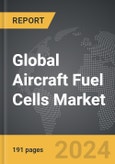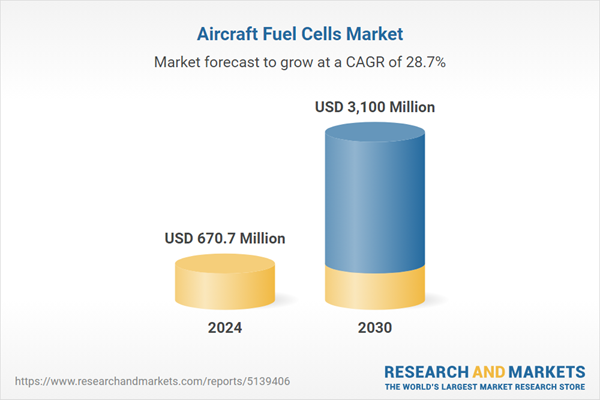The global market for Aircraft Fuel Cells was valued at US$670.7 Million in 2024 and is projected to reach US$3.1 Billion by 2030, growing at a CAGR of 28.7% from 2024 to 2030. This comprehensive report provides an in-depth analysis of market trends, drivers, and forecasts, helping you make informed business decisions. The report includes the most recent global tariff developments and how they impact the Aircraft Fuel Cells market.
The adoption of aircraft fuel cells is being driven by advancements in fuel cell technology and the increasing availability of hydrogen as a viable fuel source. Technological improvements have led to more compact, lightweight, and efficient fuel cells, making them suitable for integration into various types of aircraft, from small drones to large commercial jets. The development of robust hydrogen storage and distribution infrastructure is also crucial in facilitating the widespread use of fuel cells in aviation. Companies and research institutions are actively working on innovative solutions to overcome challenges related to hydrogen storage and fuel cell durability. These efforts are paving the way for the next generation of aircraft that can leverage fuel cells for primary or auxiliary power, enhancing overall aircraft performance and sustainability.
The growth in the aircraft fuel cells market is driven by several factors, including stringent environmental regulations, the increasing focus on sustainable aviation, and advancements in hydrogen fuel technology. Governments and regulatory bodies worldwide are imposing stricter emission standards on the aviation industry, prompting airlines and manufacturers to explore alternative propulsion systems like fuel cells. The aviation sector's commitment to achieving net-zero emissions by 2050 has accelerated the research and development of fuel cell technology. Furthermore, significant investments in hydrogen production and distribution infrastructure are making hydrogen more accessible and cost-effective, bolstering its adoption as a fuel source. Collaborations between aerospace companies, research institutions, and governments are fostering innovation and driving down costs, making fuel cell-powered aircraft a more viable option. As the industry continues to prioritize sustainability and efficiency, the demand for aircraft fuel cells is expected to grow, positioning them as a critical component in the future of aviation.
Going ahead, higher air passenger traffic would bring more flights in operation, while the pressure to reduce carbon emissions would encourage adoption of aircraft fuel cells. Hydrogen, produced from renewables, is a clean option for carriers and therefore an ideal choice for aircraft fuel cells. While smaller aircrafts (up to 20 passenger seats capacity) are currently using hydrogen-powered fuel cells, efforts are ongoing from several aircraft makers to power larger commercial aircraft with hydrogen fuel cells. Even vendors, such as in the US, are also contributing by developing fuel cell components that find application in rotorcrafts. Growing global awareness of the impending environmental crisis has worked as a catalyst for heightened interest in research and development and innovation of fuel cells for aerospace industry.
Segments: Fuel Cell Type (Hydrogen, Other Fuel Cell Types); Technology (Proton Exchange Member Fuel Cell (PEMFC), Other Technologies).
Geographic Regions/Countries: World; USA; Canada; Japan; China; Europe; France; Germany; Italy; UK; Rest of Europe; Asia-Pacific; Rest of World.
The analysts continuously track trade developments worldwide, drawing insights from leading global economists and over 200 industry and policy institutions, including think tanks, trade organizations, and national economic advisory bodies. This intelligence is integrated into forecasting models to provide timely, data-driven analysis of emerging risks and opportunities.
Global Aircraft Fuel Cells Market - Key Trends & Drivers Summarized
Aircraft fuel cells represent a cutting-edge technology poised to revolutionize aviation by providing a more efficient and environmentally friendly power source compared to traditional combustion engines. These fuel cells generate electricity through an electrochemical reaction between hydrogen and oxygen, producing only water and heat as byproducts. This clean energy generation method significantly reduces greenhouse gas emissions, aligning with the aviation industry's goals to lower its carbon footprint. Additionally, fuel cells offer higher energy efficiency and reliability, as they contain fewer moving parts and are less prone to mechanical failures. The implementation of fuel cells in aircraft can potentially lead to quieter operations and reduced maintenance costs, further enhancing their appeal.The adoption of aircraft fuel cells is being driven by advancements in fuel cell technology and the increasing availability of hydrogen as a viable fuel source. Technological improvements have led to more compact, lightweight, and efficient fuel cells, making them suitable for integration into various types of aircraft, from small drones to large commercial jets. The development of robust hydrogen storage and distribution infrastructure is also crucial in facilitating the widespread use of fuel cells in aviation. Companies and research institutions are actively working on innovative solutions to overcome challenges related to hydrogen storage and fuel cell durability. These efforts are paving the way for the next generation of aircraft that can leverage fuel cells for primary or auxiliary power, enhancing overall aircraft performance and sustainability.
The growth in the aircraft fuel cells market is driven by several factors, including stringent environmental regulations, the increasing focus on sustainable aviation, and advancements in hydrogen fuel technology. Governments and regulatory bodies worldwide are imposing stricter emission standards on the aviation industry, prompting airlines and manufacturers to explore alternative propulsion systems like fuel cells. The aviation sector's commitment to achieving net-zero emissions by 2050 has accelerated the research and development of fuel cell technology. Furthermore, significant investments in hydrogen production and distribution infrastructure are making hydrogen more accessible and cost-effective, bolstering its adoption as a fuel source. Collaborations between aerospace companies, research institutions, and governments are fostering innovation and driving down costs, making fuel cell-powered aircraft a more viable option. As the industry continues to prioritize sustainability and efficiency, the demand for aircraft fuel cells is expected to grow, positioning them as a critical component in the future of aviation.
Going ahead, higher air passenger traffic would bring more flights in operation, while the pressure to reduce carbon emissions would encourage adoption of aircraft fuel cells. Hydrogen, produced from renewables, is a clean option for carriers and therefore an ideal choice for aircraft fuel cells. While smaller aircrafts (up to 20 passenger seats capacity) are currently using hydrogen-powered fuel cells, efforts are ongoing from several aircraft makers to power larger commercial aircraft with hydrogen fuel cells. Even vendors, such as in the US, are also contributing by developing fuel cell components that find application in rotorcrafts. Growing global awareness of the impending environmental crisis has worked as a catalyst for heightened interest in research and development and innovation of fuel cells for aerospace industry.
Report Scope
The report analyzes the Aircraft Fuel Cells market, presented in terms of units. The analysis covers the key segments and geographic regions outlined below.Segments: Fuel Cell Type (Hydrogen, Other Fuel Cell Types); Technology (Proton Exchange Member Fuel Cell (PEMFC), Other Technologies).
Geographic Regions/Countries: World; USA; Canada; Japan; China; Europe; France; Germany; Italy; UK; Rest of Europe; Asia-Pacific; Rest of World.
Key Insights:
- Market Growth: Understand the significant growth trajectory of the Proton Exchange Member Fuel Cell (PEMFC) segment, which is expected to reach US$2.3 Billion by 2030 with a CAGR of a 27.7%. The Other Technologies segment is also set to grow at 32.2% CAGR over the analysis period.
- Regional Analysis: Gain insights into the U.S. market, valued at $225.1 Million in 2024, and China, forecasted to grow at an impressive 25.3% CAGR to reach $277.3 Million by 2030. Discover growth trends in other key regions, including Japan, Canada, Germany, and the Asia-Pacific.
Why You Should Buy This Report:
- Detailed Market Analysis: Access a thorough analysis of the Global Aircraft Fuel Cells Market, covering all major geographic regions and market segments.
- Competitive Insights: Get an overview of the competitive landscape, including the market presence of major players across different geographies.
- Future Trends and Drivers: Understand the key trends and drivers shaping the future of the Global Aircraft Fuel Cells Market.
- Actionable Insights: Benefit from actionable insights that can help you identify new revenue opportunities and make strategic business decisions.
Key Questions Answered:
- How is the Global Aircraft Fuel Cells Market expected to evolve by 2030?
- What are the main drivers and restraints affecting the market?
- Which market segments will grow the most over the forecast period?
- How will market shares for different regions and segments change by 2030?
- Who are the leading players in the market, and what are their prospects?
Report Features:
- Comprehensive Market Data: Independent analysis of annual sales and market forecasts in US$ Million from 2024 to 2030.
- In-Depth Regional Analysis: Detailed insights into key markets, including the U.S., China, Japan, Canada, Europe, Asia-Pacific, Latin America, Middle East, and Africa.
- Company Profiles: Coverage of players such as Advent Technologies, Airbus SAS, Australian Fuel Cells Pty. Ltd., Cummins Inc., ElringKlinger AG and more.
- Complimentary Updates: Receive free report updates for one year to keep you informed of the latest market developments.
Some of the 27 companies featured in this Aircraft Fuel Cells market report include:
- Advent Technologies
- Airbus SAS
- Australian Fuel Cells Pty. Ltd.
- Cummins Inc.
- ElringKlinger AG
- Honeywell International Inc.
- Intelligent Energy Limited
- Nuvera Fuel Cells, LLC
- The Boeing Company
Tariff Impact Analysis: Key Insights for 2025
Global tariff negotiations across 180+ countries are reshaping supply chains, costs, and competitiveness. This report reflects the latest developments as of April 2025 and incorporates forward-looking insights into the market outlook.The analysts continuously track trade developments worldwide, drawing insights from leading global economists and over 200 industry and policy institutions, including think tanks, trade organizations, and national economic advisory bodies. This intelligence is integrated into forecasting models to provide timely, data-driven analysis of emerging risks and opportunities.
What’s Included in This Edition:
- Tariff-adjusted market forecasts by region and segment
- Analysis of cost and supply chain implications by sourcing and trade exposure
- Strategic insights into geographic shifts
Buyers receive a free July 2025 update with:
- Finalized tariff impacts and new trade agreement effects
- Updated projections reflecting global sourcing and cost shifts
- Expanded country-specific coverage across the industry
Table of Contents
I. METHODOLOGYMII. EXECUTIVE SUMMARY2. FOCUS ON SELECT PLAYERSIII. MARKET ANALYSISIV. COMPETITION
1. MARKET OVERVIEW
3. MARKET TRENDS & DRIVERS
4. GLOBAL MARKET PERSPECTIVE
UNITED STATES
CANADA
JAPAN
CHINA
EUROPE
FRANCE
GERMANY
ITALY
UNITED KINGDOM
REST OF EUROPE
ASIA-PACIFIC
REST OF WORLD
Companies Mentioned (Partial List)
A selection of companies mentioned in this report includes, but is not limited to:
- Advent Technologies
- Airbus SAS
- Australian Fuel Cells Pty. Ltd.
- Cummins Inc.
- ElringKlinger AG
- Honeywell International Inc.
- Intelligent Energy Limited
- Nuvera Fuel Cells, LLC
- The Boeing Company
Table Information
| Report Attribute | Details |
|---|---|
| No. of Pages | 191 |
| Published | April 2025 |
| Forecast Period | 2024 - 2030 |
| Estimated Market Value ( USD | $ 670.7 Million |
| Forecasted Market Value ( USD | $ 3100 Million |
| Compound Annual Growth Rate | 28.7% |
| Regions Covered | Global |









